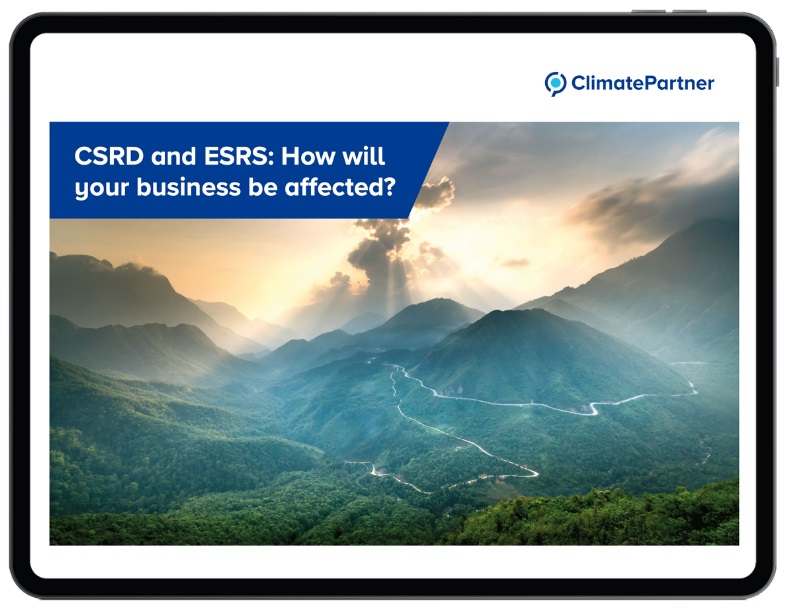
ESRS E1 Climate change
What are the ESRS E1 Climate change disclosure requirements?
The ESRS E1 standard establishes disclosure requirements to help stakeholders, such as investors, regulators, and the public, understand a company’s impact on climate change. These include the positive and negative effects of the company, its past, current, and future mitigation efforts aligned with the Paris Agreement, and its plans to adapt strategies and business models for a sustainable economy.
The Corporate Sustainability Reporting Directive (CSRD) mandates non-financial reporting for EU companies, covering environmental, social, and governance (ESG) aspects. Companies must adhere to specific "European Sustainability Reporting Standards" (ESRS), with ESRS E1 focusing on climate change.
3 steps for reporting ESRS E1 Climate change under the CSRD
- Double-Materiality Assessment (DMA): Conducted before reporting begins, the DMA identifies factors your business impacts and those impacting your business. It ensures clarity for all users, including those unfamiliar with sustainability concepts, by laying the groundwork for reporting on topical standards and disclosure requirements.
- Structured reporting: Align your disclosures with ESRS requirements (E1-1 to E1-9) based on your DMA results.
- Independent audit: Ensure your report is independently audited for compliance and accuracy.
The E1 standard aligns with EU legislation and regulations, such as the EU Climate Law, Climate Benchmark Standards Regulation, Sustainable Finance Disclosure Regulation (SFDR), EU taxonomy, and EBA Pillar 3 disclosure requirements, ensuring compliance and consistency in sustainability reporting.
9 reporting requirements for ESRS E1
E1-1: Transition plan for climate change mitigation
Provide an understanding of your company’s past, current, and future mitigation efforts. These efforts ensure that its strategy and business model align with the transition to a sustainable economy, the limitation of global warming to 1.5°C in line with the Paris Agreement, and the goal of achieving net zero emissions by 2050. It also includes the company’s exposure to coal, oil, and gas-related activities.
E1-2: Policies
Outline the extent to which your company has policies in place to identify, assess, manage, and address material impacts, risks, and opportunities related to climate change mitigation and adaptation.
E1-3: Actions and resources
Disclose the key actions taken and planned to achieve climate-related policy objectives and targets. Include details of climate change mitigation and adaptation actions, and the resources allocated for their implementation.
E1-4: Targets
State the targets your company has set to support its climate change mitigation and adaptation policies and address its material climate-related impacts, risks, and opportunities.
E1-5: Energy consumption and mix
Report your company’s total energy consumption in absolute value, improvement in energy efficiency, exposure to coal, oil, and gas-related activities, and the share of renewable energy in its overall energy mix.
E1-6: Gross scopes 1, 2, 3 and total GHG emissions
Understand your gross greenhouse gas (GHG) emissions based on the GHG Protocol:
- Scope 1: the direct impacts of your company’s activities on climate change and the proportion of its total GHG emissions regulated under emission trading schemes.
- Scope 2: the indirect emissions from energy consumed by your company, whether purchased externally or acquired.
- Scope 3: the emissions that occur in your company’s upstream and downstream value chain beyond its scope 1 and 2 emissions. Scope 3 emissions often form a significant part of a company’s GHG inventory and are a key driver of its transition risks.
E1-7: GHG removals and mitigation projects financed through carbon credits
Detail your company’s actions to permanently remove or facilitate the removal of GHG from the atmosphere, contributing to net zero targets. This includes insights into the extent and quality of carbon credits purchased or planned to purchase from the voluntary carbon market (VCM) to support climate contribution claims.
E1-8: Internal carbon pricing
Disclose whether your company applies internal carbon pricing schemes and, if so, how these schemes support decision-making and incentivise the implementation of climate-related policies and targets.
E1-9: Anticipated financial effects from material risks and opportunities
Outline your company’s anticipated financial effects from material physical and transition risks, as well as its potential to benefit from material climate-related opportunities.
If you would like to learn more about the various ESRS E1 climate change disclosure requirements and our service offerings, please get in touch.
